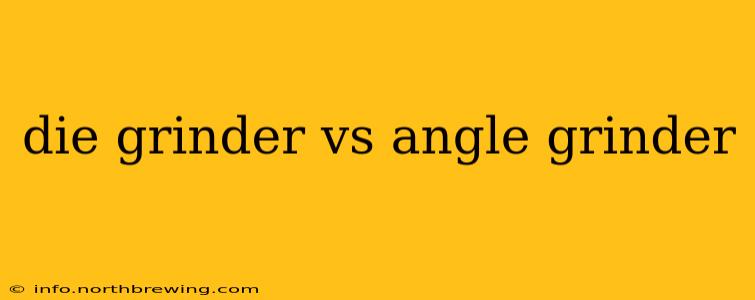Die Grinder vs. Angle Grinder: Which Tool Reigns Supreme?
Choosing between a die grinder and an angle grinder often comes down to the specific task at hand. Both are powerful rotary tools used for grinding, cutting, and polishing, but their designs and applications differ significantly. This comprehensive guide will delve into the key distinctions between these two workhorses, helping you determine which tool best suits your needs.
What is a Die Grinder?
A die grinder is a compact, high-speed rotary tool typically used for precision grinding, sanding, and polishing in tight spaces. Its smaller size and high RPM (revolutions per minute) make it ideal for intricate detail work and delicate operations. The chuck, where the grinding bits are attached, is usually a collet chuck, which allows for quick and easy bit changes.
What is an Angle Grinder?
An angle grinder, also known as a side grinder, is a more robust and powerful tool designed for heavier-duty applications. Its larger size and higher torque allow it to tackle tougher materials and more demanding tasks, such as cutting metal, grinding welds, and removing rust. Angle grinders generally use a larger disc rather than interchangeable bits like a die grinder. The angle of the motor housing gives it its name and offers better control during use.
What are the Key Differences Between a Die Grinder and an Angle Grinder?
Several key factors distinguish die grinders from angle grinders:
- Size and Weight: Die grinders are significantly smaller and lighter than angle grinders, making them easier to maneuver in confined areas.
- Power and Torque: Angle grinders boast greater power and torque, enabling them to handle tougher materials and more demanding tasks.
- Speed: Die grinders typically operate at higher RPMs, ideal for precision work. Angle grinders have lower RPMs but higher torque.
- Applications: Die grinders excel at intricate detail work, while angle grinders are better suited for heavier-duty tasks like cutting and grinding large surfaces.
- Attachments: Die grinders use a variety of interchangeable bits, while angle grinders primarily use grinding discs, cutting wheels, and polishing pads.
Which is better for cutting metal?
For cutting metal, the angle grinder is the clear winner. Its higher power and larger cutting wheels make quick work of even thick metal sheets. While a die grinder can cut metal with the right abrasive bit, it’s a far slower and less efficient process.
Which is better for grinding welds?
Again, the angle grinder is generally preferred for grinding welds. Its power and larger contact area allow for faster material removal. However, for intricate weld grinding in tight spaces, a die grinder might be more suitable.
Which is better for polishing?
Both tools can be used for polishing, but they excel in different areas. A die grinder is better for detailed polishing, such as on intricate parts or small areas. An angle grinder, with the right polishing pad, can be used for larger surfaces, but care must be taken to avoid damaging the material.
Which is better for detail work?
The die grinder's smaller size and higher RPM make it perfectly suited for detail work and precision grinding. It's far easier to control in tight spaces and allows for a higher level of accuracy.
Which is safer to use?
Both angle grinders and die grinders pose safety risks if not used correctly. Always wear appropriate safety gear, including eye protection, hearing protection, and a dust mask. Proper training and understanding of the tool's operation are crucial for safe use. Smaller die grinders may seem less dangerous due to their size, but the high speed can still be hazardous.
Conclusion: Choosing the Right Tool for the Job
The choice between a die grinder and an angle grinder depends heavily on the specific task. For precision work, intricate details, and smaller projects, a die grinder is ideal. For heavier-duty applications such as cutting metal, grinding welds, and removing rust, an angle grinder is the superior choice. Consider the power requirements, workspace constraints, and the level of precision needed when making your decision. Remember always to prioritize safety when operating either tool.
